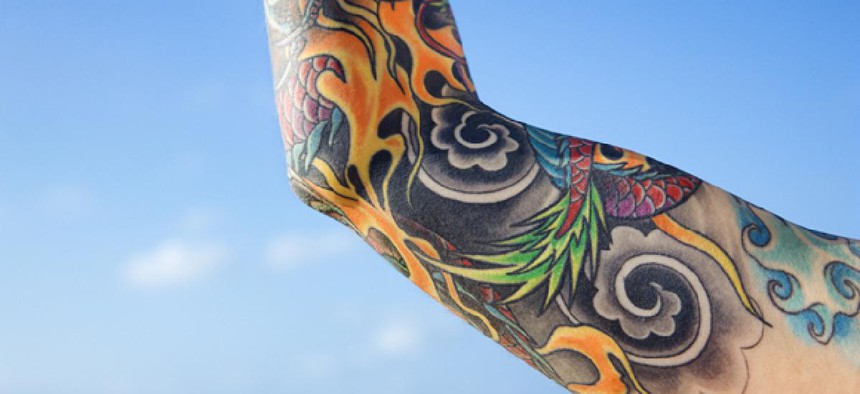Capitol Police issue new tattoo rules
Limitations are among a new set of 'Grooming Standards.'
Top U.S. Capitol Police officials want to impose stricter rules on “purposeful body modification” by their officers, including limits on the sizes and messages of tattoos on uncovered arms and legs, and a ban on “outwardly visible branding” of images on skin.
The limitations, some of which are creating a stir among the cops who protect the U.S. Capitol complex, are among a new set of operational directives contained in a policy manual handed down two weeks ago from higher-ups, under a heading on “Grooming Standards.”
Some officers, including those who hold top union positions on the U.S. Capitol Police Labor Committee, say they do not have a problem generally with the effort at providing greater clarity on what’s allowed in terms of tattoos, branding, or body piercings. For instance, they agree that it is unprofessional to publicly exhibit offensive, gang-related, or profane tattoos or markings while on duty.
But some Capitol cops -- who do not want to be identified, fearing reprisal for openly discussing an internal department matter -- complain that some of the new restrictions, as written, venture awkwardly into the personal. They point to a provision declaring, “Tattoos/body markings of any kind that -- in their totality -- cover more than one third of the area of exposed skin on an arm or leg are to be deemed excessive and must be covered while on duty.” That is followed by language stating, “The chief of police or designee is the final authority as to the appropriateness of any tattoo/body markings.”
Some officers ask whether the department’s top officers or supervisors could use tape measures to decipher whether tattoos on, for example, officers wearing uniform short pants as they are assigned to bicycle patrol, cover more than a third of the exposed part of the leg.
Another section under the heading “Body Modification” even prompted initial concern, though it now appears unwarranted, that the top brass sought to ban breast implants for women officers. The section states that “body modification other than for medically necessary rehabilitative purposes or common cosmetic procedures is prohibited.” It goes on to define “purposeful body modification” as including “any outwardly visible branding, scarring, resection, [or] subcutaneous implantation.”
“This took us totally by surprise,” said one officer, while another complained that by infringing on such personal matters, the rule has strayed over a line “that should never be crossed.”
Rich Roberts, a spokesman for the International Union of Police Associations, based in Sarasota, Fla., said he has been advised that there are a number of U.S. police departments that have imposed breast-implant bans. But the Capitol Police spokeswoman, Lt. Kimberly Schneider, said it is a mistake to read the department’s new language in the directives as doing so, because it’s not the case.
“It actually doesn’t say that,” Schneider said. The new directive even specifies that the banned procedures include “subcutaneous implantation,” not “submuscular” implants. Police union officials who asked not to be identified have since said that they do not, in fact, view that language as banning breast implants.
More generally, though, the new directives on tattoos and body markings represent a significant expansion of what is not acceptable. They also go beyond that to discuss and present limits, specifically, on the topic of “body modifications.”
The new policies state, “Any visible tattoos/body markings that are deemed offensive, profane, unprofessional, inappropriate or objectionable must be covered while on duty,” with examples of those including “criminal gang affiliation, depictions of sexually explicit art, nudity, or violence, etc.”
Previous directives stated that, “whenever possible, tattoos must be covered when in uniform” and those that couldn’t be covered were not “to contain language or characterizations that are derogatory or offensive to any social economic or ethnic group.”
Asked why the higher-ups were expounding so on the topic of officers’ tattoos, spokeswoman Schneider replied that the new policy manual “was created as part of our efforts to reinforce uniformity throughout the agency in support of the USCP’s mission and goals.”
IUPA spokesman Roberts said U.S. Capitol Police brass are not alone in delving into this topic, noting that other police departments across the country have instituted tattoo-related guidelines or orders for their officers.
The Capitol Police union’s chairman, Jim Konczos, declined to discuss any specific concern or issue arising out of the proposed new guidelines. But he acknowledged that there are a number of issues.
Initially, the new general orders were to take effect on the last day of July. But the union has appointed a panel to start an intensive review next week, and discussions are expected between the union and acting Police Chief Thomas Reynolds that could impact a final version of the directives. The proposed orders actually bear the signature of Reynolds’s predecessor, Phillip Morse, who retired as chief earlier this year.
“There are concerns, but our acting chief Reynolds has given us the opportunity to negotiate this,” said Konczos.
(Image via iophoto/Shutterstock.com)




